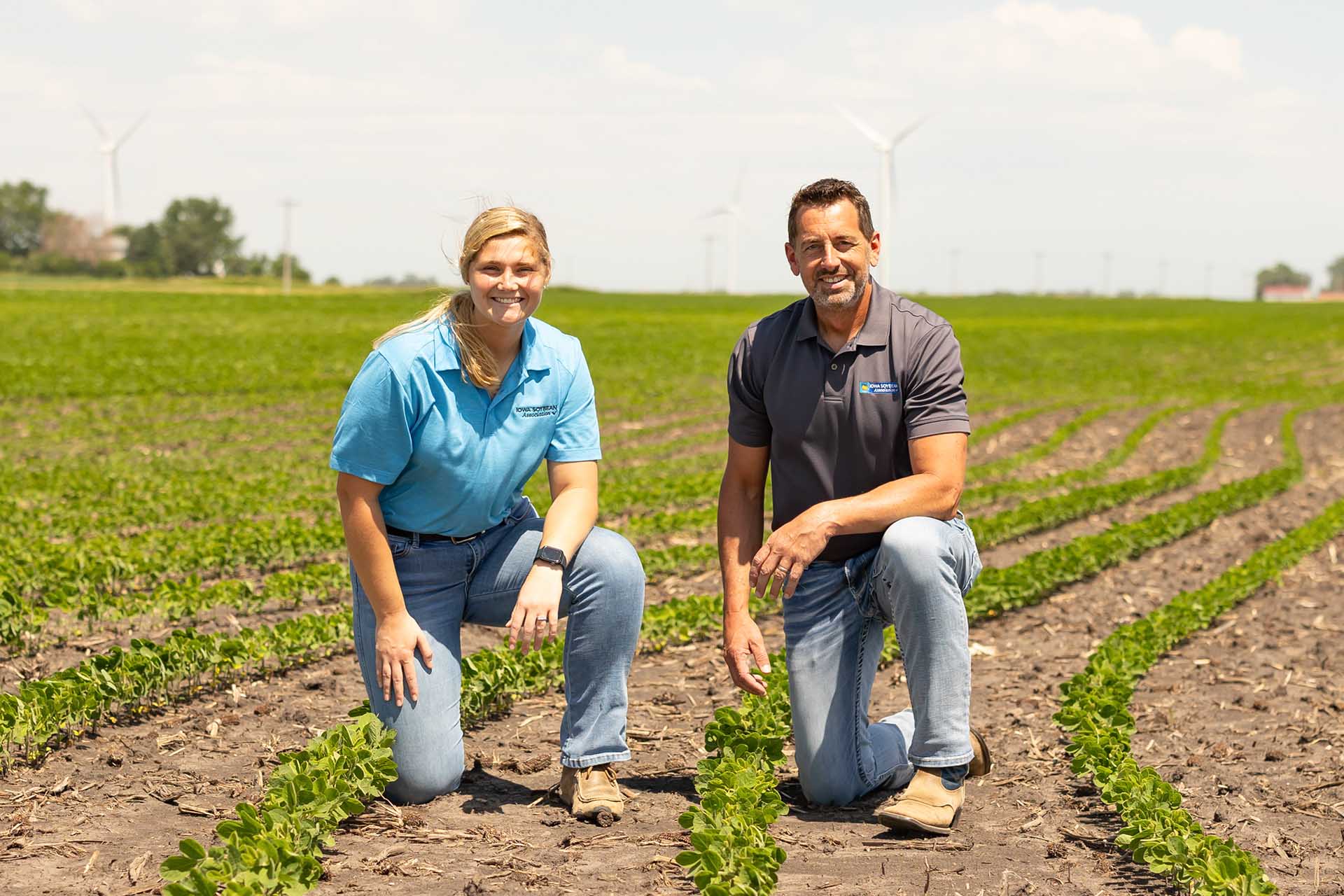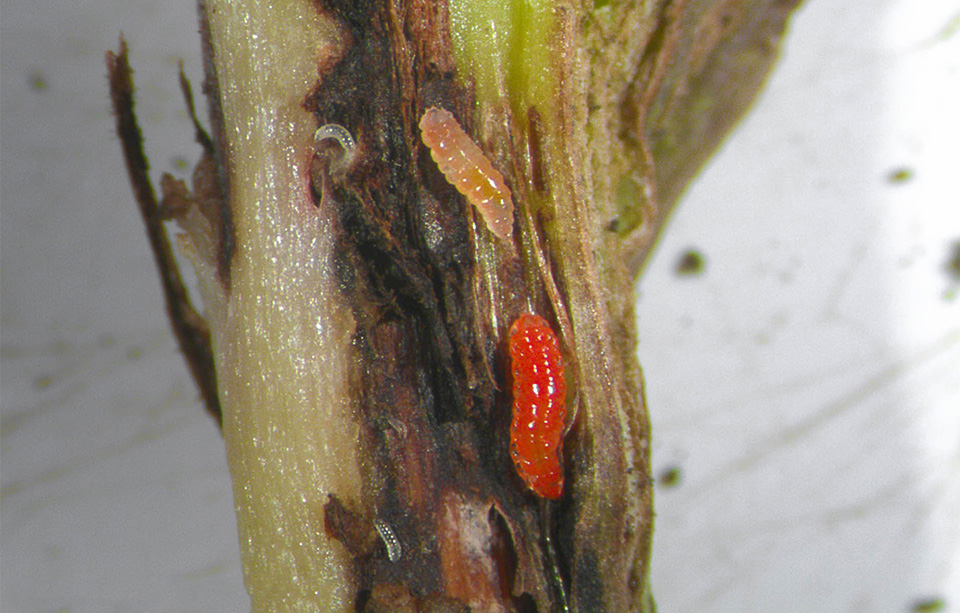
Research agronomists Mikaela Lawrence and Drew Clemmensen (Photo: Iowa Soybean Association / Joclyn Bushman).
Walking Rows: ISA agronomists update – June 20
June 20, 2024 | Kriss Nelson
High humidity, soil moisture and rain are a recipe for disease. Iowa Soybean Association (ISA) research agronomists are urging farmers to not only be scouting for diseases in their crops but to be aware of any failed post-emergence herbicide applications and pests, including bean leaf beetles and soybean gall midge.
Drew Clemmensen – Northwest/Western Iowa
Soybeans across the area look good, with most in the V2- V4 stage and a few fields starting to flower. April planted corn is in the V6 to V8 stages, finding its nitrogen and growing quickly, although there is still an unevenness to many fields from areas that stayed too wet for too long.
Planters have been put away for the season. Replanting is finished, but some areas in my districts have not been planted. I advise drone seeding these areas with a cover crop so the ground doesn’t sit fallow. This will help keep weeds from germinating and spreading.

Scout for insects and diseases as we continue to have favorable weather for both. Bean leaf beetles are showing up in fields, although not at threshold levels. Soybeans are also reaching the stage where soybean gall midge activity begins. In corn acres, assess for corn rootworm larvae.
Scouting for these pests is also an opportune time to make notes for next year. Assess plant stands and dig plants to observe root growth to understand how the planter performed and how the planting conditions affect plant growth.
Shane Beck – Northeast/Northern Iowa
Both soybeans and corn conditions are improving in my area.
Planting soybeans when the ground was a little too wet has resulted in a decrease in populations in several fields. This has caused sidewall compaction and crusting. Most of these fields maintain a good enough stand where a replant isn't necessary. Still, a reduction in root development may lead to a yield decrease, especially if we experience drier conditions in the next few months
The corn has finally received the heat it needed to grow, and it has either reached the nitrogen levels that were applied earlier in the spring or last fall or has received a recent application of nitrogen.
Over the past few weeks, I have been working on a herbicide tolerance trial for Group 14 herbicides. In this trial, we compare side-by-side strips of a Group 15 herbicide with a Group 14 and 15 herbicide. This trial aims to determine if Group 14 herbicides cause injury to plants as they emerge from the ground and if this injury results in any yield loss. After scouting the fields, I observed minimal injury caused by both the Group 14 and 15 herbicides. Based on what I have seen, I do not expect to see a significant yield loss. We will collect yield data this fall and thoroughly analyze the two treatments.
Alex Schaffer – Central Iowa
I have noticed some unsuccessful herbicide applications where weeds are not dying. Now is a good time to scout for any weeds that were sprayed, showing new growth. They will continue to grow and eventually cause a seed bank issue. Following herbicide labels, using surfactants, multiple nodes of action and full rates, and understanding how certain chemistries work on broadleaf weeds versus grasses could help your post-emergence herbicide applications work.
In drowned-out areas that will most likely remain barren, you must keep an eye out for weeds and spot-spray those areas to prevent weeds from getting out of control.

I have heard some reports of tar spot in corn. Considering the hot and rainy weather, I encourage farmers to regularly inspect their fields for diseases.
I've observed blooms on the lower nodes of soybean plants this week. Now is the time to decide if you will be applying a fungicide. Ideally, this application would be done at the R3 stage as pod filling begins. You will want to look for diseases between now and then to consider a fungicide application. Protecting the soybean plant after pollination and when the pods start to fill is important.
Lucas De Bruin – Southeast/Eastern Iowa
Currently, the conditions in my southeast and eastern Iowa districts are favorable, with minimal disease or weed pressure. Post-emergence soybean herbicide applications are currently taking place. Remember, spraying weeds when they reach a height of four to six inches is essential.

Corn planted in April and May has formed a canopy, and side dressing nitrogen in corn is ending. Farmers who have chosen a two-pass fungicide application have begun the first round of application.
Mikaela Lawrence – Southwestern/Southern Iowa
Some farmers in my district are working to finish planting. Heavy rains earlier this week halted the task. My area has a wide range of plant growth, with soybeans from the cotyledon stage to V5 and flowers beginning to form. Corn ranges from V2 to V10.
According to the Soybean Research and Information Network, farmers should begin scouting for soybean gall midge when soybean plants reach the V2 stage. Wilting or dead soybeans along field edges with decreasing damage into the center of the field is usually the first sign of infestation.

Soybean Gall Midge
While inspecting an Improved Cropping Systems trial near Villisca, the corn is growing rapidly alongside the cover crop decomposing. Now is the time to consider fall trials with ISA, including Iowa Nitrogen Initiative, Improved Cropping Systems and Manure Sense.
Back